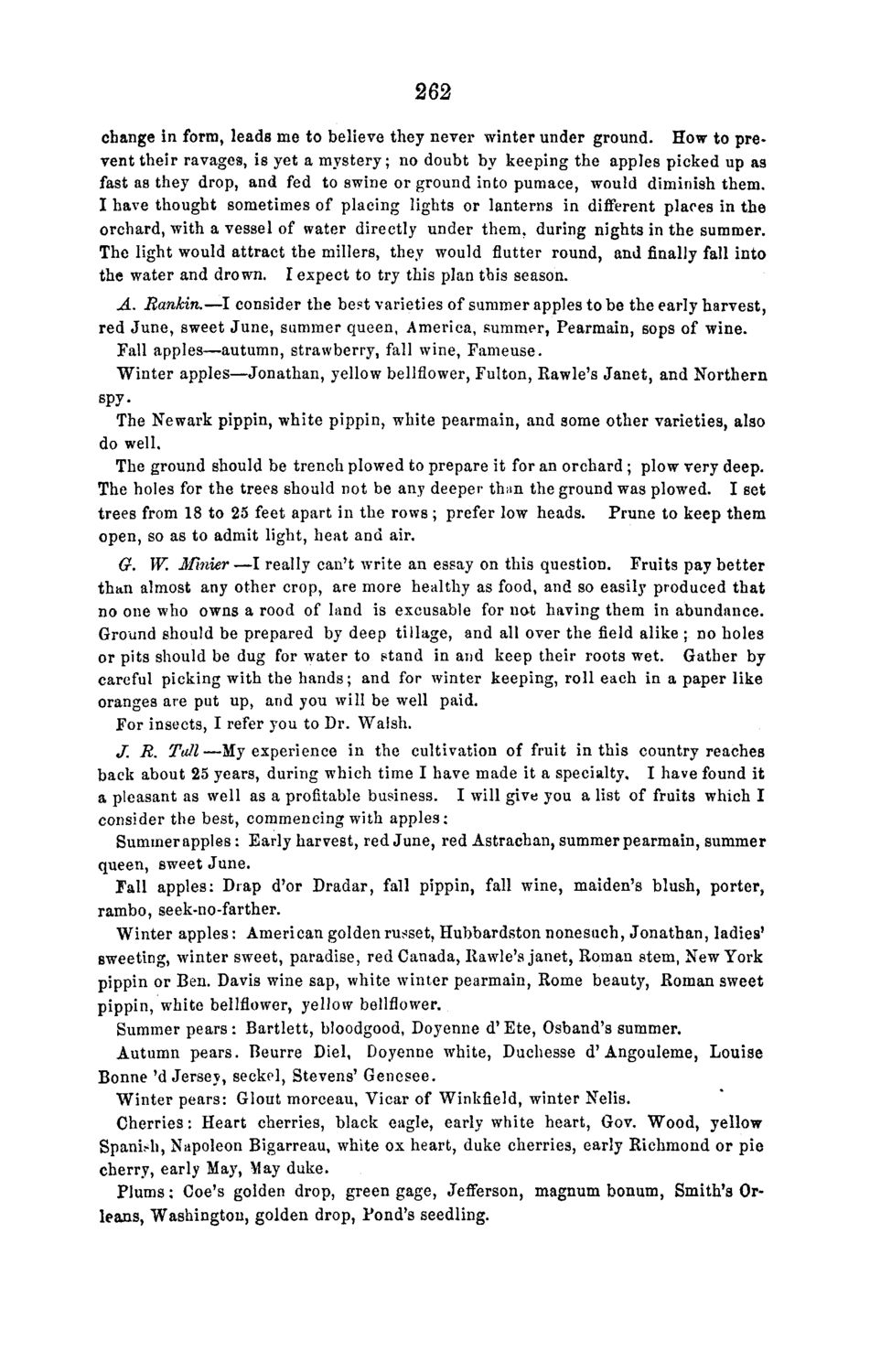| |
| |
Caption: Board of Trustees Minutes - 1868
This is a reduced-resolution page image for fast online browsing.

EXTRACTED TEXT FROM PAGE:
262 change in form, leads me to believe they never winter under ground. How to prevent their ravages, is yet a mystery; no doubt by keeping the apples picked up as fast as they drop, and fed to swine or ground into pumace, would diminish them. I have thought sometimes of placing lights or lanterns in different places in the orchard, with a vessel of water directly under them, during nights in the summer. The light would attract the millers, they would flutter round, and finally fall into the water and drown. I expect to try this plan this season. A. Rankin.—I consider the best varieties of summer apples to be the early harvest, red June, sweet June, summer queen, America, summer, Pearmain, sops of wine. Fall apples—autumn, strawberry, fall wine, Fameuse. Winter apples—Jonathan, yellow bellflower, Fulton, Rawle's Janet, and Northern spyThe Newark pippin, white pippin, white pearmain, and some other varieties, also do well. The ground should be trench plowed to prepare it for an orchard; plow very deep. The holes for the trees should not be any deeper thun the ground was plowed. I set trees from 18 to 25 feet apart in the rows ; prefer low heads. Prune to keep them open, so as to admit light, heat and air. G. W. Minier—I really can't write an essay on this question. Fruits pay better than almost any other crop, are more healthy as food, and so easily produced that no one who owns a rood of land is excusable for nat having them in abundance. Ground should be prepared by deep tillage, and all over the field alike ; no holes or pits should be dug for water to stand in and keep their roots wet. Gather by careful picking with the hands; and for winter keeping, roll each in a paper like oranges are put up, and you will be well paid. For insects, I refer you to Dr. Walsh. J. R. Tall—My experience in the cultivation of fruit in this country reaches back about 25 years, during which time I have made it a specialty, I have found it a pleasant as well as a profitable business. I will give you a list of fruits which I consider the best, commencing with apples: Summer apples: Early harvest, red June, red Astrachan, summer pearmain, summer queen, sweet June. Fall apples: Drap d'or Dradar, fall pippin, fall wine, maiden's blush, porter, rambo, seek-no-farther. Winter apples: American golden russet, Hubbardston nonesuch, Jonathan, ladies' sweeting, winter sweet, paradise, red Canada, Rawle's janet, Roman stem, New York pippin or Ben. Davis wine sap, white winter pearmain, Rome beauty, Roman sweet pippin, white bellflower, yellow bellflower. Summer pears: Bartlett, bloodgood, Doyenne d' Ete, Osband's summer. Autumn pears. Beurre Diel, Doyenne white, Duchesse d'Angouleme, Louise Bonne 'd Jersey, seckel, Stevens' Genesee. Winter pears: Glout morceau, Vicar of Winkfield, winter Nelis. Cherries: Heart cherries, black eagle, early white heart, Gov. Wood, yellow Spanish, Napoleon Bigarreau, white ox heart, duke cherries, early Richmond or pie cherry, early May, May duke. Plums: Coe's golden drop, green gage, Jefferson, magnum bonum, Smith's Orleans, Washington, golden drop, Pond's seedling.
| |